The key to life is water—but the second-most-used substance on Earth is concrete. We produce enormous volumes of concrete each year and the amount is rising significantly with population growth and emerging economies. It might surprise you, as it did me, to learn that every year, concrete production worldwide generates as much as 9 percent of all human carbon dioxide (CO2) emissions. This makes concrete a major greenhouse gas contributor to climate change, so any reductions that we can make in this footprint will be helpful. Fortunately, more sustainable advances are slowly being developed and implemented.
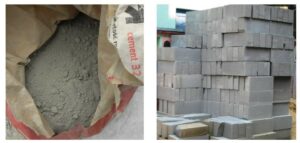
Cement and concrete masonry bricks (Wikimedia)
Cement, Concrete, and Construction
We make concrete by mixing crushed rock or sand with cement, the binder that holds the aggregate together as it hardens. Cement happens to be one of the most energy-intensive products we produce, made in enormous kilns at extremely high temperatures. Limestone, consisting cheifly of the mineral calcite (calcium carbonate, CaCO3) is a major ingredient of cement. This sedimentary rock typically forms in warm and shallow marine environments and is exposed widely across the surface of our planet. In marine settings, calcium carbonate precipitates out of seawater with contributions primarily from the skeletons of plankton, mollusks, corals responsible for reef formation, and other invertebrate creatures.
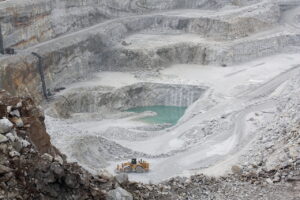
Limestone quarry in Norway (Wikimedia)
To make cement, quarried limestone is mixed with a silica source such as fly ash (fine particles of burned coal) and fired in a kiln at temperatures as high as 2,640 o F (1,450 o C). During the heating process some of the material stays in a solid state but up to 30% of the mixture becomes molten. The material removed from the kiln is called clinker, and once ground into a fine powder and mixed with a few additives, producers can package it as cement. At a building site, the cement is mixed with water and aggregates of sand and small rocks to make concrete. A chemical reaction occurs when the clinker dissolves and recombines with water and silica, forming the calcium silica hydrates that make concrete strong as well as porous.
Fossil fuels used to heat the large kilns and the heating process to make clinker both produce large amounts of CO2. Concrete production also requires a tremendous amount of water. In many regions, this places a strain on the drinking water and irrigation supply since much of the consumption of concrete is occurring in drought and water-stressed regions. In cities, concrete absorbs the warmth of the sun and adds to the heat-island effect—not what we need on our rapidly warming planet. Limestone quarries are significant sources of wind-blown dust, which can affect workers and regional populations with respiratory diseases such as silicosis. The trucks carrying materials between quarries, cement factories, and construction sites create significant emissions. The finished product suffocates ecosystems, covers fertile soil, creates hard surfaces that impede storm-water runoff and groundwater recharge, replaces storm-resisting mangrove swamps, and other adverse impacts.
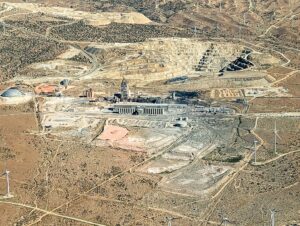
CalPortland Mojave Cement Plant in California (Wikimedia)
An additional concern of which I am especially aware: the acquisition of sand for aggregate is problematic, given the scale of the demand for concrete. Beaches and riverbeds around the globe are being destroyed in pursuit of sand; organized and violent crime gangs increasingly run this form of mining. (My blog post Desert Countries Import Sand? has interesting information.)
A Few Highlights in Concrete History
Roughly 3,000 years ago, the first steps in the development of cement began when burned, damp limestone was used to coat the outsides of pounded-clay buildings in the Middle East—after this coating reacted with gases in the air, it formed a hard and protective surface. Builders made the earliest cement by crushing and burning gypsum or limestone in the kilns that were used to make pottery, then adding sand and water to make mortar, a plaster-like material. Over millennia, people improved these mixes and the processes involved in making concrete.
The Romans excelled in using concrete from about 300 BCE to 476 CE. Based on the knowledge of previous generations, they took advantage of local volcanic sands that can react chemically with lime and water. Builders used Roman concrete for many structures that are still admired today, including the Pantheon and Colosseum in Rome, as well as ancient aqueducts, baths, docks, and seawalls.

The dome of the Pantheon in Rome, completed in 125 CE (Wikimedia)
The concrete construction of the Pantheon illustrates the impressive technical sophistication of the Roman builders. This large structure features what is reportedly the largest un-reinforced concrete dome ever built. Completed in 125 CE, it includes a dome that is 142 feet (43 m) in diameter. At the peak of the dome 142 feet (43 m) above the floor is a 27-foot (8.2 m) diameter hole, called an oculus, which lightens the structural load of the dome. To reduce stresses in the dome and save weight, the builders used concrete with successively less dense aggregates as dome units increased in height. At the thickest point, the principal aggregate was travertine (a form of freshwater limestone), then terracotta (earthenware) tile fragments, and at the top, volcanic pumice.
Fast forward to 1824, when the Portland cement that is in use today was invented by an Englishman named Joseph Aspdin. The new material resembled high quality limestone building stones quarried on the Isle of Portland in Dorset, England, so that became the source of the name. After years of experimentation involving different ingredients and kiln temperatures, manufacturers produced Portland cements of modern composition. Today, we use detailed standards for design mixes that are adjusted to the different forces that the concrete will need to resist, such as lateral loads, gravity, and chemical attack.
Many improvements to concrete have been introduced over the years. Buildings that incorporated steel- reinforcing bars in concrete were first constructed beginning in the late 1870s. In 1903, builders constructed the first reinforced concrete high-rise building in Cincinnati, Ohio. Known as the Ingalls Building, it stands at 16 stories or 210 feet (64 m) tall. In 2021, Courtyard by Marriott converted the building to the Marriott Cincinnati Downtown hotel. The Burj Khalifa skyscraper in Dubai is reportedly the world’s tallest building, with the primary structure assembled from reinforced concrete. The building opened in 2010, is 163 stories high, and has a total height of 2,722 feet (830 m).
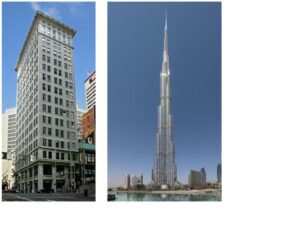
The Ingalls Building in Cincinnati, Ohio that opened in 1903 and the BurjKhalifa in Dubai, UAE that opened in 2010 (Wikimedia)
Experience with reinforced concrete eventually led to construction of relatively thin shells of concrete to build structures with stable shapes, such as roofs in the shape of domes, arches and compound curves. I have always admired the photos of the Sydney Opera House – and hope to someday visit Sydney and see this impressive structure.

Sydney Opera House in 2011, Sydney, Australia (Wikimedia)
One more interesting and surprising fact about concrete is that only in the past few years have researchers understood how Roman concrete could be so stable. Modern reinforced concrete lasts about one hundred years without major repairs, and some concrete structures crumble within decades. In contrast, the Pantheon with the unreinforced dome and other ancient Roman constructions have survived for almost two millennia. It turns out that Roman concrete has a self-healing capacity. The Roman builders apparently used a type of lime called quicklime (calcium oxide) in a high temperature, “hot mixing” process that produced many small lumps of lime in the concrete mixture. Tiny cracks that form later within this material will travel through the high-surface-area lime clasts and then react with water, which recrystallizes the calcium carbonate and quickly fills a crack before it can spread further. This new knowledge can be used to produce more durable concrete formulations with an extended functional lifespan—in the long run requiring less energy to maintain and lower emissions.
Looking Ahead
Concrete is synonymous with development. Meeting demands for housing, tunnel linings, water conveyance channels, dams, roads, seawalls, and many other structures typically rely on concrete. However, the world needs the emissions associated with the use of this material to fall fast. Given the tremendous array of construction projects where concrete is used, different alternatives and processes will need to be implemented. I list some of these below.
— Use renewable energy to replace fossil fuels in cement kilns and for steps in the mixing and transport of concrete.
— Use blended cement that contains less clinker. One process mixes unheated limestone in the final grinding step of cement production, and another replaces some of the cement in concrete with ingredients such as fly ash, which has been shown to result in fewer emissions without a loss of strength.
— Use an optimal mix of ingredients for a project by moving away from prescriptive requirements and selecting concrete contents based on performance-based specifications.
— Capture and store or utilize the CO2 emitted during cement production.
— Improve the maintenance of existing structures, and when it is not possible to conserve one, employ enhanced concrete recycling.
Some companies are already working on these improvements. Solidia, using technology originally developed at Rutgers University, has developed a more sustainable cement manufacturing process that uses less energy with lower kiln temperatures and a concrete curing technology using CO2 instead of water (see https://www.solidiatech.com/). CarbonCure has developed a technology that allows producers to inject captured CO2 into fresh concrete during mixing and that manufacturers can retrofit into existing concrete plants (see https://www.carboncure.com/ ). Other companies are working on similar innovations.
Change can be slow. For large and complex structures especially, engineers, architects, contractors, and clients are understandably cautious about novel building materials. In some parts of the world there is tremendous corruption associated with concrete, and construction projects involve kickbacks and bribes. Politicians, bureaucrats, and construction companies are “set” in their ways. But as the world heats up, there are measures that can be implemented to reduce the negative effects of cement and concrete production. The cooperation of researchers, industry, and governments will be essential. The future for concrete doesn’t need to be set in stone.
If you liked this post, please share it and/or leave a comment or question below and I will reply – thanks! And if you’d like to receive a message when I publish a new post, scroll down to the bottom of this page, and leave your email address on my website. Join now to learn more about geology, geography, culture, and history.
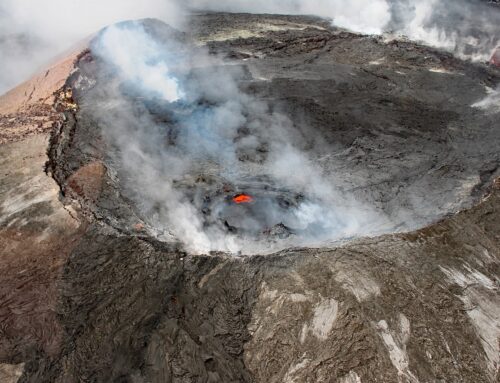




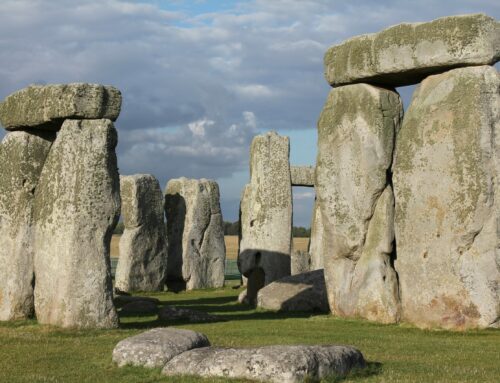
Very interesting. Especially about the longevity of ancient concrete
Thanks for the comment!
Thanks, Roseanne. I was quite unaware of the role played by concrete in climate change. Very informative!
Thanks Diana!
Very informative about it affecting climate change and how ingenious of the ancient builders
Thanks, Robin!
Thanks for the post! I well remember taking my geology classes to the Clarkdale Cement Plant in Arizona’s Verde Valley and having tours of the entire process. This is where the Mississippian Redwall Limestone was/is quarried and all of the cement in the Glen Canyon Dam came from this source.
Interesting! Thanks for the comment, Wayne!
This “Concrete Concerns” offers a thoughtful exploration of the complexities and considerations involved in concrete construction, providing valuable insights for professionals and enthusiasts alike. Keep on sharing!
Good to hear – thank you for this comment!